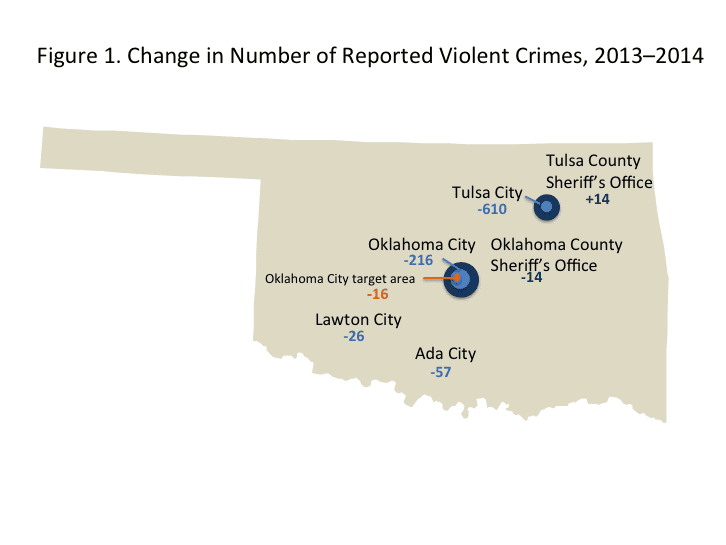Reinvesting in Law Enforcement to Reduce Crime: Oklahoma’s ‘Safe Oklahoma Grant Program’
Faced with one of the highest violent crime rates in the country in 2010, Oklahoma state policymakers created the Safe Oklahoma Grant Program to fund law enforcement-led strategies to reduce violent crime as part of the state’s Justice Reinvestment effort. Between 2013 and 2015, almost $4 million was distributed to more than a dozen local law enforcement agencies to help implement new or enhance existing data-driven policing strategies. [Feb. 2017 UPDATE:The state of Oklahoma reports that approximately $5.3 million was awarded to local law enforcement agencies from FY2013–FY2016 as part of the Safe Oklahoma Grant Program.] The grant program prioritizes work that targets five key areas related to preventing violent crime: implementing evidence-based policing strategies; increasing technological capacity to support crime prevention; improving analytical capacity; engaging with community partners; and providing victim services.
To ensure that this grant program funds violence-prevention best practices, the Oklahoma Office of the Attorney General provided law enforcement executives applying for the program with technical assistance opportunities. Specifically, Dr. Robin Engle, Director of the Institute of Crime Science at the University of Cincinnati, briefed executives on emerging evidence-based policing best practices and assisted grant applicants in formulating proposals that supported such strategies.
In 2013, Oklahoma issued its first funding awards for the Safe Oklahoma Grant Program, awarding almost $2 million to 6 recipients: Oklahoma City Police Department ($750,000), Tulsa City Police Department ($625,000), Lawton Police Department ($250,000), Ada Police Department ($100,000), Oklahoma County Sheriff’s Office ($100,000), and Tulsa County Sheriff’s Office ($75,000). The program has since awarded approximately $2 million in additional funding to law enforcement departments across the state.
While no two departments followed the same approach, each recipient used funds from the grant program to implement a number of strategies designed to prevent and reduce violent crime, including:
- focusing on quality of life initiatives, which include enforcement of code violations and removal of graffiti;
- implementing intelligence-led (or “hot spots”) policing;
- promoting community education and engaging community leaders;
- and targeting gun-, gang-, and sex-crimes, as well as domestic violence.
In order to fully support and implement these strategies, the departments allocated some of the grant funds for overtime pay.
“Oklahoma needed to focus on reducing our high rates of violent crime,” said Bill Citty, Chief of the Oklahoma City Police Department. “State policymakers realized through the justice reinvestment process that law enforcement needed resources to help us use data-driven strategies to reduce violent crime in the communities most impacted by it.”
An early evaluation by the Oklahoma State Bureau of Investigations of the Oklahoma City initiative showed that the number of reported violent crimes fell 6 percent between 2013 and 2014 in the neighborhoods targeted by this program that used the aforementioned crime reduction strategies. Research suggests that neighborhood-centered efforts are an important component of successful violence-reduction strategies; however, these efforts were too limited in each of the jurisdictions in Oklahoma to have been a definitive factor in the citywide changes in the number of reported crimes shown in Figure 1. Most grantee jurisdictions experienced a decrease in the number of reported violent crimes between 2013 and 2014; however, reported violent crime in the jurisdiction of the Tulsa County Sheriff’s Office increased. [See Figure 1]
 Recent research has shown that investments in evidence-based policing strategies can be six to seven times more cost effective at preventing crime than investments in increasing the length of stay in prison, but more research is needed to explore what approaches work best for small jurisdictions with few resources. The initial trends in Oklahoma should prompt policymakers and law enforcement leaders in other jurisdictions pursuing a similar approach to consider further evaluations to understand the impact of the grant-funded activities and whether any strategies are particularly effective. Providing answers to these questions will assist policymakers in determining if the reinvestment of justice dollars in front-end crime prevention strategies can lead to reductions in local crime and overall jail and prison admissions.
Recent research has shown that investments in evidence-based policing strategies can be six to seven times more cost effective at preventing crime than investments in increasing the length of stay in prison, but more research is needed to explore what approaches work best for small jurisdictions with few resources. The initial trends in Oklahoma should prompt policymakers and law enforcement leaders in other jurisdictions pursuing a similar approach to consider further evaluations to understand the impact of the grant-funded activities and whether any strategies are particularly effective. Providing answers to these questions will assist policymakers in determining if the reinvestment of justice dollars in front-end crime prevention strategies can lead to reductions in local crime and overall jail and prison admissions.
This project was supported by Grant No. 2010-RR-BX-K071 awarded by the Bureau of Justice Assistance. The Bureau of Justice Assistance is a component of the Department of Justice’s Office of Justice Programs, which also includes the Bureau of Justice Statistics, the National Institute of Justice, the Office of Juvenile Justice and Delinquency Prevention, the Office for Victims of Crime, and the SMART Office. Points of view or opinions in this document are those of the author and do not necessarily represent the official position or policies of the U.S. Department of Justice.
Arkansas policymakers have long expressed concerns about the state’s high recidivism rate. Over the past 10 years, an…
Read MoreIn April 2025, Arkansas Governor Sarah Huckabee Sanders signed a package of bipartisan criminal justice legislation into law,…
Read More Explainer: Key Findings and Options from Arkansas’s Justice Reinvestment Initiative
Explainer: Key Findings and Options from Arkansas’s Justice Reinvestment Initiative
Arkansas policymakers have long expressed concerns about the state’s high recidivism rate.…
Read More Explainer: How a New Law in Arkansas Tackles Crime, Recidivism, and Community Supervision Challenges
Explainer: How a New Law in Arkansas Tackles Crime, Recidivism, and Community Supervision Challenges
In April 2025, Arkansas Governor Sarah Huckabee Sanders signed a package of…
Read More









